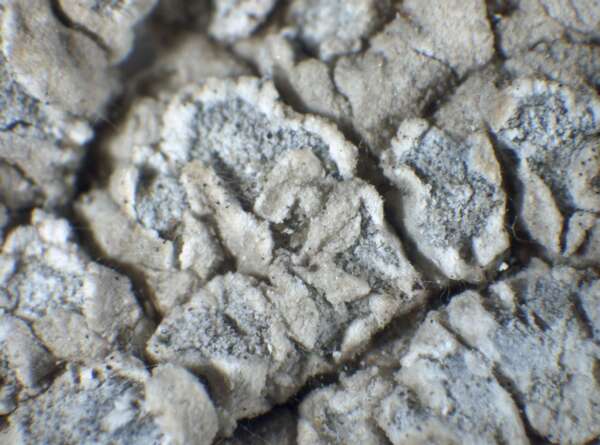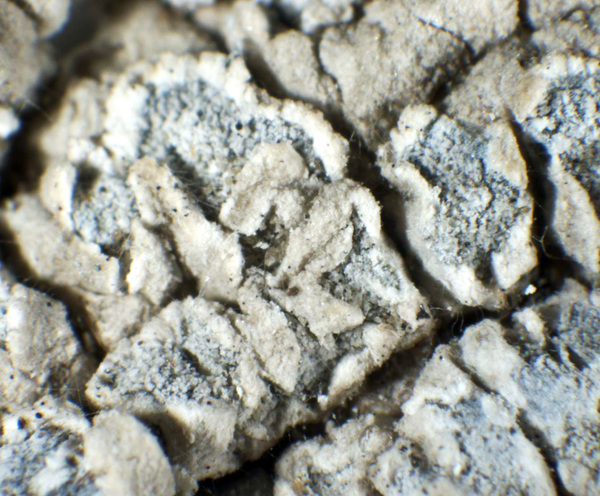Pertusaria paramerae A. Crespo & Vězda
Anal. Jard. Bot. Madrid, 41, 2: 252, 1985.
Synonyms:
Distribution: S - Bas.
Description: Thallus crustose, thinly episubstratic, white-grey or with a yellow-brown tinge, continuous to rimose-areolate. Apothecia numerous, crateriform, not constricted at base, immersed into 0.5-1.5 mm wide fertile warts, with an initially punctiform, later irregularly open, black disc covered in a thick, white pruina, and a prominent thalline margin. Epithecium yellowish green, K+ and N+ pink-violet; hymenium colourless; paraphyses rather lax, branched and anastomosing; hypothecium colourless. Asci 1-spored, broadly cylindrical, the apex with a broad ocular chamber, the outer sheath K/I+ blue, otherwise K/I-, with an inner extensible layer, Pertusaria-type. Ascospores 1-celled, hyaline, ellipsoid, 120-190 x (40-)60-75(-90) µm, double-walled, the wall 5-8 µm thick, faintly transversally striate. Photobiont chlorococcoid. Spot tests; thallus K+ pale yellow, C-, KC+ yellow orange P-, UV+ orange. Chemistry: planaic acid (major), 4-O-dimethylplanaic acid, plus traces of thiophaninic acid, atranorin (trace), 2,4-dichloronorlichexanthone, and an unidentified substance.Note: this species was described from the Iberian Peninsula, where it mostly grows on Juniperus thuriferain the supramediterranean belt, but also on J. phoenicea and J. oxycedrus in the eu-Mediterranean belt. According to Sipman (in litt.), who has studied the specimen, the earlier record of P. rhodiensis from Basilicata (see Nimis 1993: 519) refers to P. paramerae. The species, which is also known from Turkey, is chemically variable (see Halici & al. 2010).
Growth form: Crustose
Substrata: bark
Photobiont: green algae other than Trentepohlia
Reproductive strategy: mainly sexual
Commonnes-rarity: (info)
Alpine belt: absent
Subalpine belt: absent
Oromediterranean belt: absent
Montane belt: extremely rare
Submediterranean belt: absent
Padanian area: absent
Humid submediterranean belt: extremely rare
Humid mediterranean belt: extremely rare
Dry mediterranean belt: absent

Predictive model


P.L. Nimis; Owner: Department of Life Sciences, University of Trieste
Herbarium: TSB (9176)
2002/05/14

Detail from: https://gzu.jacq.org/GZU000287772
GZU000287772 - Crespo,A. & Vězda,A. Vězda, A.: Lichenes Selecti Exsiccati 1979 Date 1983-05-24
Location Spain / Castilla y León
Label Hispania. Prov. Soria, prope vicum Judes, Paramera ; Alt. 1250 m
Habitat Ad corticem Juniperi thuriferae, in Junipereto thuriferae soluto
Growth form: Crustose
Substrata: bark
Photobiont: green algae other than Trentepohlia
Reproductive strategy: mainly sexual
Commonnes-rarity: (info)
Alpine belt: absent
Subalpine belt: absent
Oromediterranean belt: absent
Montane belt: extremely rare
Submediterranean belt: absent
Padanian area: absent
Humid submediterranean belt: extremely rare
Humid mediterranean belt: extremely rare
Dry mediterranean belt: absent

Predictive model


P.L. Nimis; Owner: Department of Life Sciences, University of Trieste
Herbarium: TSB (9176)
2002/05/14

 INDEX FUNGORUM
INDEX FUNGORUM
 GBIF
GBIF


